
All actors have their own motivation to work hard and be part of movies that have large veiwership and recognition. The motivation could be either financial success or great praise for their work by critics and the auidence.
We will explore the relationship between different movie genres and also trends in actor/actress experience to study the career paths they have followed to make certain observations about how the industry has evolved and understand what popular actors have done to have a successful career in the movie industry.
Why is this interesting and what are the benefits?
Movie studios and production companies constantly strive to make popular movies that entertain it’s audience while also getting good ratings from the mass population. We study how movies have changed their strategies over different generations to satisfy the audience preference at that time. By exploring the relationship between actor/actress experience and movie genres, we can gain valuable insights into the factors that contribute to an actor’s success within specific genres. This information can be useful for movie studios and production companies as they can enhance their casting decisions and movie genre choice for future projects by looking at past projects, as well as for actors and actresses looking to advance their careers within particular genres.
In addition to understanding what factors contribute to success within specific genres, our analysis can also help us identify trends in the characteristics of successful actors within different genres. By comparing successful actor profiles from different generations within specific genres, we can see how the qualities and experiences that lead to success have changed over time. This information can be useful for actors and actresses looking to succeed in specific genres, as it can help them understand what qualities and experiences are likely to lead to success in those genres.
Our analysis also has the potential to inform future research on the relationship between actor/actress characteristics and success within specific genres. By providing a foundation for further research, we can help researchers build on our findings to explore this topic in more depth or to examine other factors that may contribute to success within specific genres.
Finally, our analysis could inform policy decisions related to the film industry. For example, if we find that certain actor characteristics are associated with success within specific genres, policymakers may consider ways to support and promote actors with these characteristics within those genres.
Analysis of genres in the movie industry
Typically, a single film can be classified as many film genres. It’s pretty intricate how various film genres interact with one another. The frequency of movie genre combinations in our base movie dataset will be displayed by a chord diagram, where the width of the connection lines denotes the frequency, in order to provide a clear picture of the genre pattern that existed in the film business.
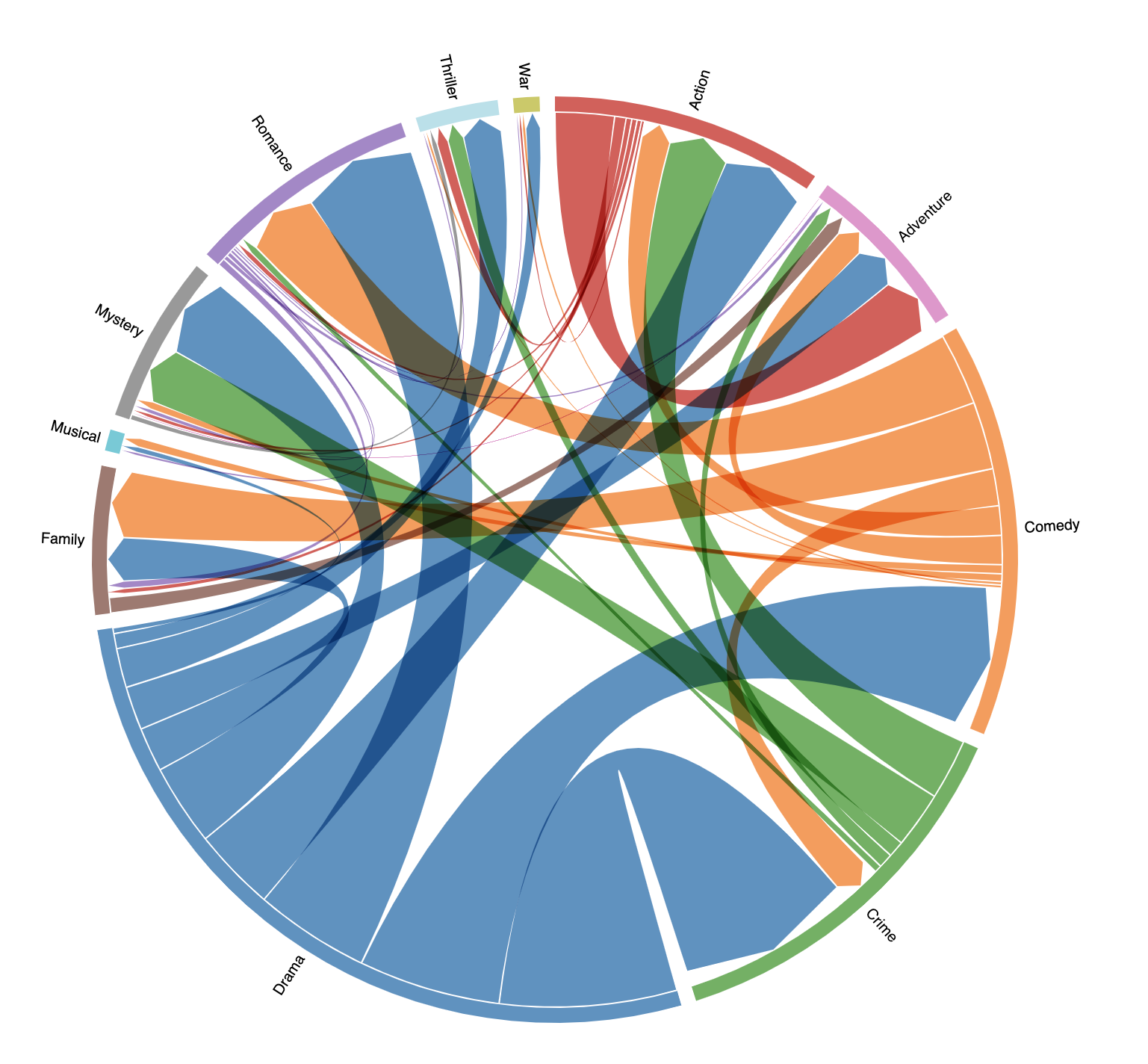
Several genres were removed from the diagram based on how frequently they appeared in our dataset, leaving only the most widely used genres. We can see that the drama genre is closely related to the other genres, which suggests that a drama movie will be a wise choice if rookie actors are unsure of what to look for in their debut movie because it will give them vital experience that many films can use. Meanwhile, we see that there is a strong association between certain genre pairs, such as comedy and family, action and adventure. Additionally, if two movie genres are significantly connected, we anticipate that an actor or actress with appropriate prior acting experience in one genre will benefit from landing a job in the other. Let’s further investigate this matter…
Investigating impact of movie experience
We develop features about each actor or actress’s experience in each well-known film genre—drama, action, romance, comedy, crime, war, family, and mystery in order to substantiate the aforementioned claim. In light of this, we make movie-actor pairs using all of the films and actors in our dataset. Now, we have statistical information on the actor’s experience in all prominent movie genres that depicts the actor’s background before filming the movie. We assume that an actor who has already appeared in films of the same genre has a higher chance of landing a role when they audition. By using a correlation analysis, we can determine which types of movie experiences will increase actors’ chances of getting a role in a new film.
In the figure above, for each row we first selected movies of the same genre G and then computed pairwise correlation of genre G with other genres. A higher correlation value means a greater chance of landing a part in the appropriate film. For instance, the majority of film genres exhibit strong correlations with drama. If you were never involved in a romance movie and you want to get a chance to film a romance movie, the experience of drama and comedy movies will help you to survive the audition. These results, we believe, will assist aspiring actors in exploring their career under supervision.
Analysis of movie experience over the generations
We now know movie experience caters to the success of actors and actresses, thus it is worth looking at it in more detail - especially how it changed over the generations. To do so, we first divide our dataset into subgroups defined by when the movies were released. The reasoning is better explained later on; in a nutshell it is part of a stratified analysis we conduct. The following generations are considered:
Greatest Generation (born circa 1901 to 1924)
Silent Generation (circa 1925 to 1945)
Baby Boomers (circa 1946 to 1964)
Boomers (circa 1965 to 1985)
Millennial Generation (circa 1985 to 1996)
Gen Z (post-Millennial) (circa 1997 to 2012)
Gen X (circa 2013+)
To ultimately analyse movie experience over time, we examine the number of movies each leading actor/actress had starred in as lead before each movie which inter alia reveals how their career has progressed over time. If a an actor is a lead or not, is determined by IMDB - our data source for this analysis. Looking at the graph “Average Actor Movie Experience Before Movie Start”, we can clearly see that the trend for having more experienced actors in a cast is certainly there. This is, however, the overall view. Therefore, unexperienced actors do not necessarily need to worry to not be picked for roles. Or should they? The answer is as often: it depends. In this case it depends on the genre which the graph “Average Actor Movie Experience Before Movie Start Per Genre” proves.

For instance, a century ago the genres “Drama” and “Action” required on average a movie experience of below half a movie. However in the latest generations, these two genres alongside “Comedy” have a much higher average starting point when looking at the average data of leading actors.
On the other hand, the “Romance” genre has the slowest increasing slope when it comes to the average bar of movie experience for leading actors in the field. To this day, leading romance actors have less than 1 movie experience when starring in romance movies. As a result, this genre can be regarded as the historic breeding soil and playground for unexperienced actors to start their career. Considering the conclusions from our earlier analysis of movie experience’s impact, we can argue that one of the most common career paths is to firstly shot a movie in Romance and then continue acting as lead in Drama or Comedy.
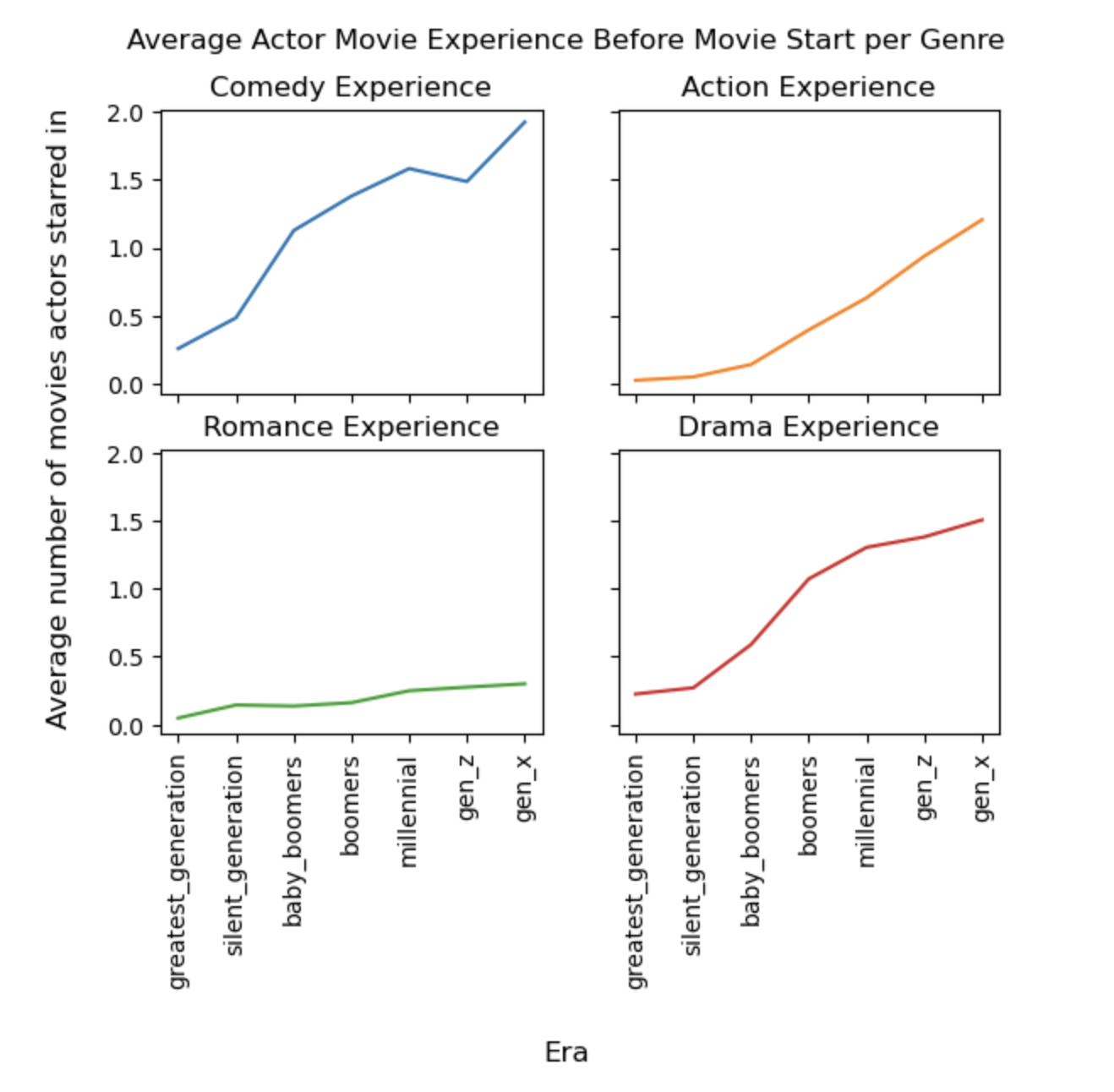
Looking at the top 1000 actors only
For further inspection, we pick out the top 1000 actors in all of the considered generations and calculate the distribution of their experience per movie genre and end up with the following graph. The top actors are chosen by the number of movies they’ve starred in; we pick the ones with the most acting experience.
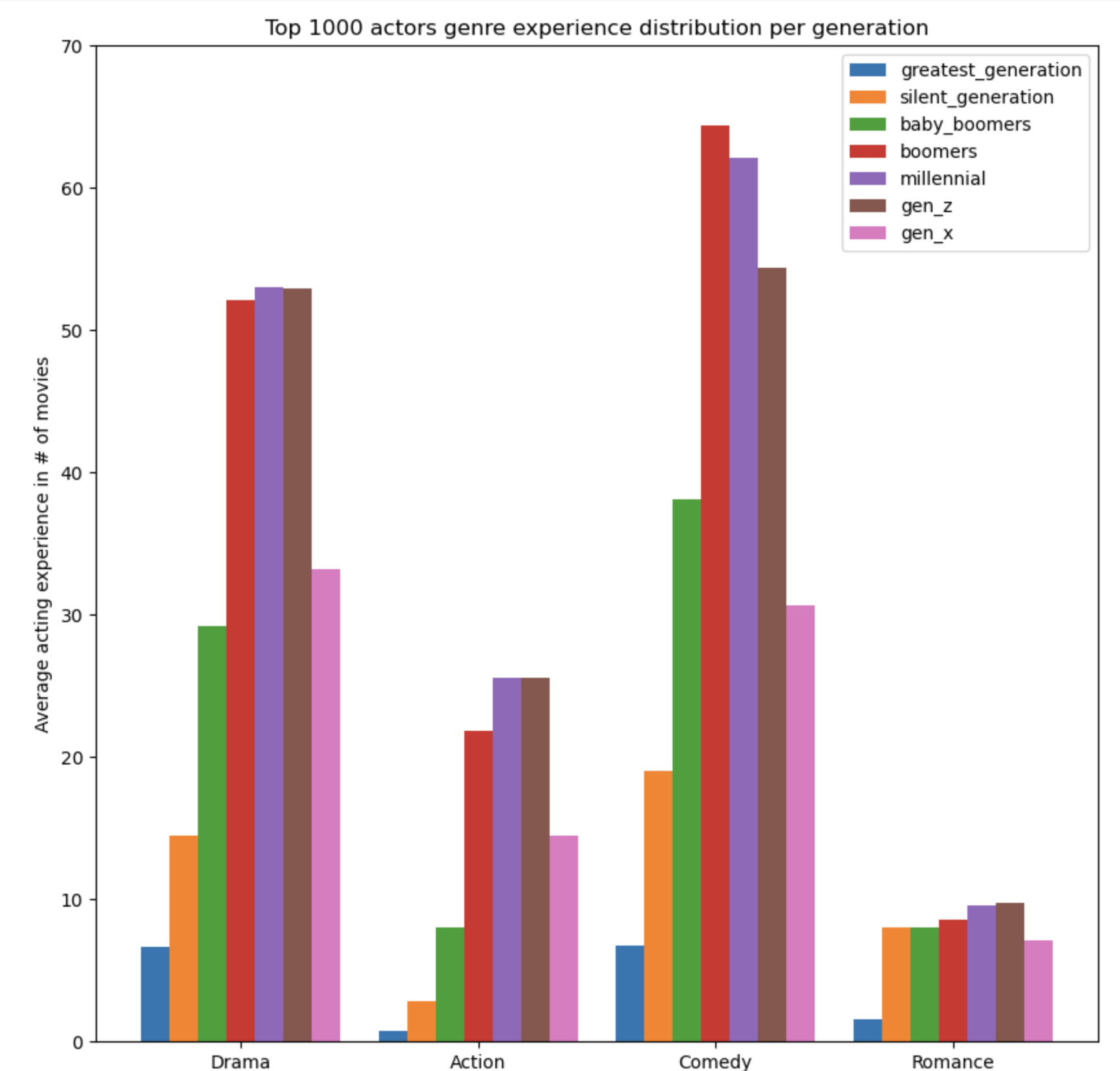
As it can be seen for the four main genres, the first 3 generations we are considering generally see a strict increase in actor experience for all genres, but starts plateauing between the boomers and gen_z generations. These are generally the generations considered to be a “golden age of cinema” with rapid technological advancements due to an outpouring of funding which saw the release of many popular and critically acclaimed movies.
However, the latest gen_x is not to be necessarily discounted either; the seeming drop in average acting experience of the top 1000 actors/actresses could be due to the fact that the generation is still ongoing, and that the talents contributing to these statistics are still growing.
It is also interesting to make a distinction between male and female actors in our analysis, as there may be differences in the distribution of experience among male and female actors in different movie genres. So we look the above again while differentiating between the top actors and actresses.
The most notable matter we first realize is that we still observe the same overall trend of average acting experience increasing during the first generations and then plateauing. However, there remains stark differences too.
We find that male actors tend to have more experience in Drama, Action and Comedy while both genders have comparable experience in Romance movies. This could suggest differences in the types of roles that are available to male and female actors, and the way that their careers are developed within the film industry.
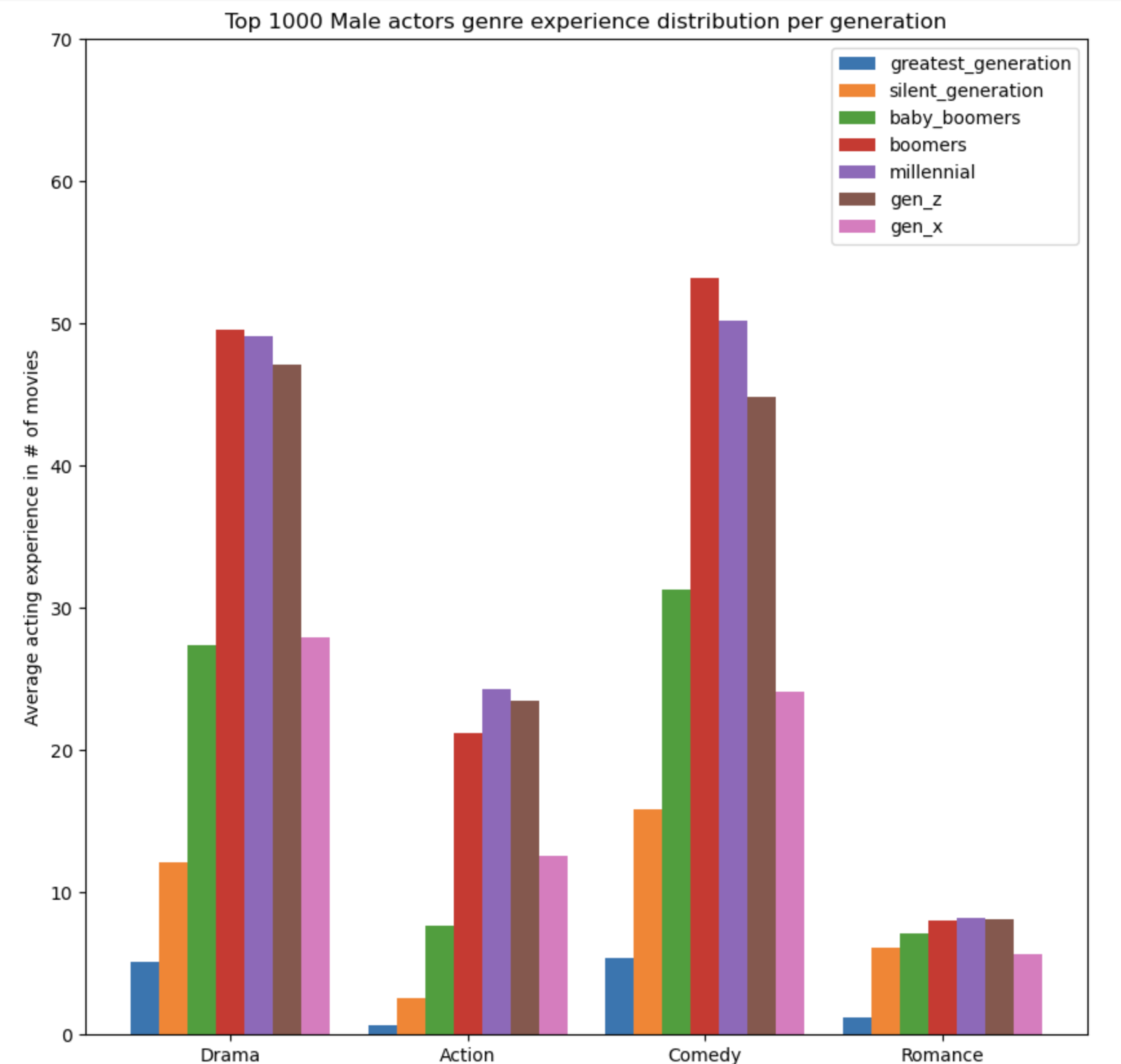
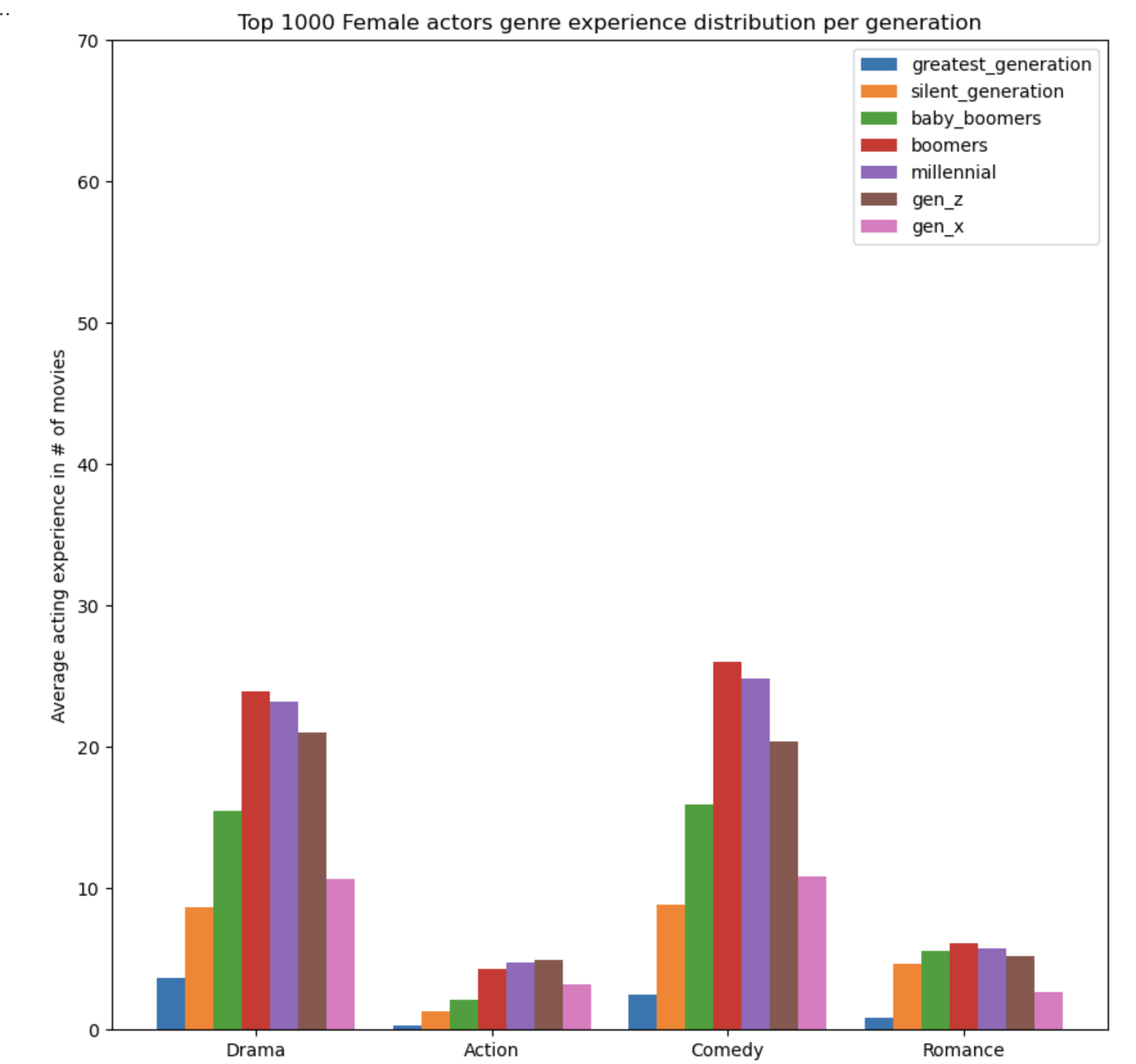
Overall, it is clear to see that the top male actors have almost twice as much average experience than female actors. It is not uncommon for male actors to have more experience than female actors in the film industry, as men have historically been more represented in leading roles and have often had more opportunities to work on a wider range of projects. This is a clear bias between males and females; it suggests that there are significant disparities in the career opportunities available to male and female actors within the film industry. It could also indicate that male actors are more likely to be cast in lead roles of the studied genres. On the other hand, it could also be interpreted in a way that favors aspiring female actors; on average you need less movie experience than men to be recognized as a top female actor.
However we remain aware of the potential confounders
When analyzing the relationship between actor/actress experience and movies for different time periods there are unobserved latent variables that might be implicitly affecting our results
-
Movie-making technology: The technology available for making movies can change over time, and this could potentially impact the success of a movie. For example, advances in special effects or cinematography could make a movie more visually appealing and impact its box office success.
-
Audience preferences: The preferences of moviegoers can also change over time. What may have been popular in one era may not be as popular in another. It’s important to consider how audience preferences may have changed over the different time periods we are analyzing.
-
Economic conditions: Economic conditions can also impact the success of a movie. For example, during times of economic downturn, people may be less likely to go to the movies or may have less disposable income to spend on entertainment. It’s important to consider how economic conditions may have differed between the different time periods we are analyzing.
-
There are other factors that could potentially impact the success of a movie, such as the quality of the script, the marketing campaign, or the performance of the actors. Unfortunately we can’t possible have access to such information, but we can shield our selves by using a sensitivity analysis model (what we saw in week 6 of class)
Some ideas we implemented to control confounding variables
- Stratified analysis : We divided our data into subgroups that depend on time periods (think baby boomer era vs gen Z era for example) to reduce the impact of the previously considered confounders; movies in the same time-period are much more likely to be made using similar technology and during comparable economic conditions. We can see how audience preference shifts through time (by seeing how the top movies genres vary through time for example)
We recognize that it is impossible to completely encapsulate the effect of the confounders, but we hope that by taking them into consideration and communicating the limits of our analysis we are increasing the validity of our analysis.
Of course, there are still drawbacks; using IMDB average movie rating and the number of votes as a measure of movie success has some limitations. For example, these measures may not be directly related to box office revenue, and there could be other factors that influence the IMDB rating or the number of votes a movie receives that are not related to the quality or success of the movie. However, using these measures can still provide valuable insights into the relationship between actor/actress experience and movie success.
What about the current generation ?
Having studied the trends in actor experience and audience perference over past generation, we are now going to study the current trends in the movie industry.
In order to study general trends between actors and genres, we filtered out certain genres such as Animation, Biographies and Documentaries as they might only feature voice actors, or depend heavily on the subject of the movie.
The current generation movie dataset consists of movies released between the period 2013 - now, from many different genres such as:

From the figure above we observe that the major genres are Drama, Comedy, Adventure, Action, Romance. It is not surprising that the most common genre is “Drama” since it is the broadest genre which is defined as - movies that are intended to be more serious than humourous in tone. Some film marketers even argue that “Drama is not a real genre” because it does not convey a lot to the audience, nevertheless it still forms an integral part of our analysis in order to make associations.
Are many genres clubbed together or do we have single genre movies?
There are many reasons for a movie to have more than one genre :
- Nature of the genres: Superhero movies are a combination of Action, Adventure and Sci-Fi
- Increase in the scale of production: No limit on possibilities
- Satisfy the audience with diverse interests: Viewership from different interest groups
- Rising demand for novelty in the movie production and storyline: Experimentation
With the exception of Comedy and Drama we see that many other popular movie genres are not singletons in the figure below.
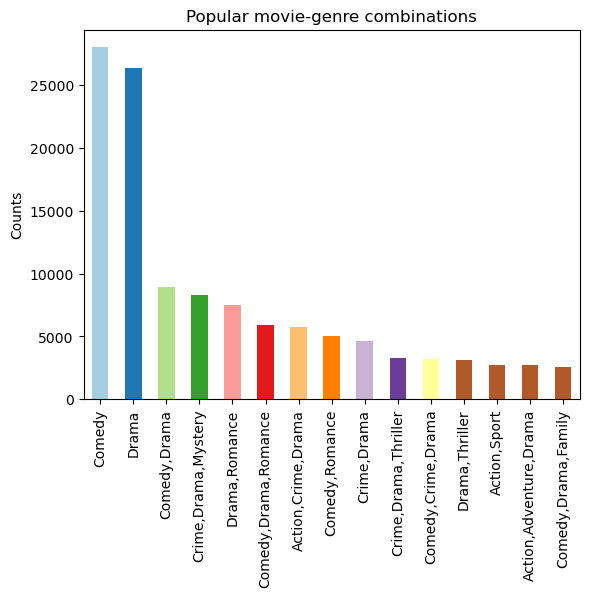
We can thus make associations of the major genres using the correlation map (between actor experience and movie genre) and the genre combinations distribution as:
- Drama - Mystery, Crime, Thriller, Comedy, Romance,
- Romance - Drama, Comedy
- Comedy - Family, Romance, Drama
- Action - Adventure, Crime, Sport
- Adventure - Action, Drama
The figures above suggest that unless an actor/actress wishes to stick strictly to either comedy or serious movies, they need to be comfortable playing very diverse roles in order to have a long illustrious career. Let us further investigate if this the reality of the current generation moviestars.
Do leading movie actor/actresses stick to the same genre?
In order to do this, we must calculate a diversity metric based on the past experience of an actor and also filter out the movie stars of our current generation. For this we consider relevant experience in the major genres.
We add up the movie counts weighted by their IMDb ratings to look at well-rated career paths, and calculate a vector $V_g$ denoting Weighted Experience (WE) in the major genres, simply put-
\[V_g = \text{WE([Drama, Romance, Comedy, Action, Adventure])}\]Now we wish to calculate whether this vector is more uniform or skewed towards a genre pair or group.
Genre entropy for actors
We define a diversity metric called genre entropy (GE) to represent if an actor has ventured into many different genres or stuck to the genre of movies they have already worked on. We first normalize the vector $V_g$ to represent a probabilistic distribution for the genre choices made by the actor/actress and then calculate the shannon’s entropy($H$) of this vector. So simply put,
\[\text{Genre Entropy (GE)} = H(\text{normalized}(V_g))\]A higher value signifies more diversity in genres of their past movies. The highest value of 2.32 (=$\log_2(5)$) is attained for the case where an actor has equal weighted experience for all the major genres (Uniform distribution).
Filtering for moviestars
Using number of votes on the IMDb ratings of their past movies as a popularity metric we plot the Genre entropy for the top 10 male and female moviestars.

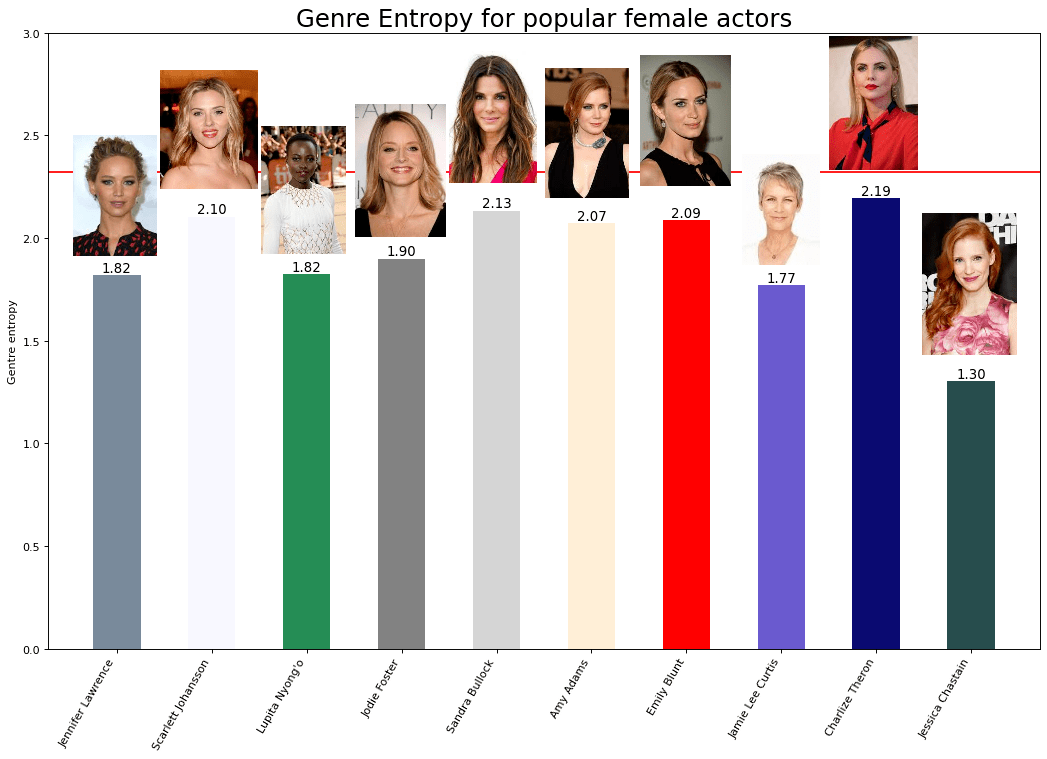
Oh Wow! We have accidentally assembled the Avengers! Does not come as a surprise since many of them of are blockbuster movie actors. In the figure above we see that many of the well-known actors have a diverse career because their genre entropy is very close to the max value signifying a high-degree of uniformity in their choice of genres among the major ones. These results thus signify that some of the topmost popular, famous and financially successful actors do tend to diversify their genre experience.
Given the advancements in the scale of production of movies and CGI, it is better for an actor to build credibility and versatility in order to be open to more roles in the movie industry. This also helps build trust among big producers and world-renowned directors regarding filling in the shoes of the leading role especially for big budget movies.
Conclusion
Through the medium of our analysis we have attempted to find genre associations, trends in actor experience requirements over different generations and genres and understand the career paths followed by popular and experienced actors. We have verified many popular beliefs, built diversity metrics to quantify genre diversity and also found ways to leverage the nature of an actor’s experience to understand trends in career decision making, casting requirements and what type of movies are compatible for them. Some of the key inferences being:
One does not require much experience to be part of romantic movies but also cannot hope to stay the Romeo or Juliet of the industry for long, because you will most likely be replaced by fresh faces.
Action/Adventure/Superhero movies require a little more experience to enter but can possibly lead to big blockbuster opportunities in the future only once you are at the brink of stardom or have enough experience and versatility.
A career in comedy is very promising because you can choose to stick to your strengths and have long career or venture into different compatible genres such as Romance, Family, Drama. Think about it, who does not like good comedy movies? The catch is the initial experience barrier is high. This can be due to the fact that it is tricky to introduce a fresh face in comedy, which is why many of the popular comics are famous for their work before movies such as stand-ups or TV show sketches.
Finally - Drama! There are two ways to look at this genre, 1. The serious movies 2. Broader definition that includes movies with a humorous aspect. The serious movies have a very specific theme and style. Actors that specialize in these types of movies, develop an identity of their own and are often accredited with major awards for their performance and contribution to the art. They may not be as diverse in their genre choices; one good example is Joaquin Phoenix (GE = 1.8) - 4 time Academy award winner and very well known for playing dark roles in serious movies. The broader interpretation is overused and conveys that the movie is plot-driven and demand that every character and scene move the story forward. This may not be much, but it does help build associations between genres in our analysis and helped us categorize the data in order to derive meaningful results.
Thus we have demonstrated how we can follow an analytical approach to understand trends in the movie industry over different generations and genres and derive meaningful inferences from our findings to help actors and movie casters make better decisions.